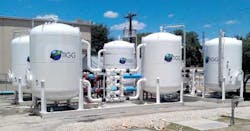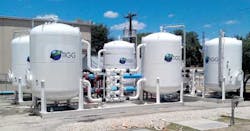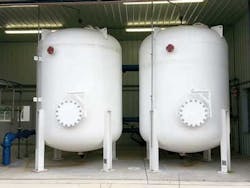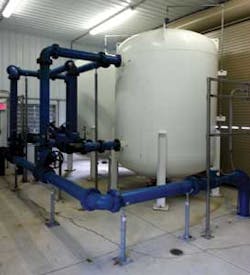By Tom Bourke
Municipal drinking water providers looking to reach regulatory compliance or to solve other potable water problems where activated carbon adsorption vessels are primarily utilized sometimes turn to rental equipment as a quick remedy. As the efficiency and cost factors are evaluated over time, the rented vessels can be purchased or upgraded as a permanent drinking water purification solution.
When Sussex County, Del., saw a steady increase in tetrachloroethylene (PCE) levels in potable water at its Industrial Airpark Well #2, engineering consultants began evaluating three different methods of treatment. These possible treatment technologies included ion exchange, which was found to be ineffective in removing PCE; air stripping, which required additional pumping; and activated carbon, which was determined to be the most effective and economical solution.
"The Delaware Division of Public Health did a random test at the Sussex County Industrial Airpark system and discovered relatively high concentrations of PCE," said Heather Sheridan, Sussex County director of environmental services. "Though the concentration was below the state's maximum contaminant level, we wanted to take a proactive approach. On the advice of our consultants, we moved quickly to install GAC (granular activated carbon) water treatment equipment."
The Industrial Airpark system serves 27 industries and approximately 900 people on 600 acres of developed land at the Sussex County Airport. Overall, the county operates two potable water systems and four wastewater treatment facilities, serving a total of 64,775 equivalent dwelling units.
The county's Department of Environmental Services, which runs and maintains the two systems, deemed the PCE concentration level an emergency and decided that renting a GAC adsorption system was the fastest way to address the issue.
The nature of the problem required an immediate response and meant the normal bidding process was placed on hold until a temporary system was installed. As such, the Sussex County Engineering Department rented and installed two CANSORB CP-3,000 activated carbon adsorption vessels. Each of the GAC units handles a maximum flow rate of 235 gpm, has a maximum pressure of 75 psi and has a standard media fill of 3,000 pounds of activated carbon.
"The filter units were delivered in a matter of days," said Julie Cooper, a Sussex County project engineer. "The county staff provided the materials and labor for installation and piping."
According to Cooper, before the Industrial Airpark Well #2 was put online with the two rented vessels running in parallel, sampling was done before and after the filtration vessels. Once the filtration units were installed, testing revealed that the contaminant influent level was 4.5 micrograms per liter, and after treatment, the effluent level was less than zero micrograms per liter.
"Activated carbon is a good adsorption media for a multitude of organic compounds, and PCE is one of them," said Anthony Mazzoni, TIGG Corporation vice president. "It's a textbook application. PCE is strongly adsorbed by activated carbon, even at low concentrations."
TIGG designed, manufactured and delivered the rental GAC units, and once they were operational, the company's technical experts worked with Sussex County's staff to create a permanent filtration solution. Due to county requirements, the project for permanent potable water filtration units was selected to be bid.
When looking to purchase new GAC units, Sussex County decided to upgrade from the 3,000-pound carbon bed in the rental units to two adsorbers with a maximum flow rate of 500 gpm, 125 psi and a 10,000-activated-carbon bed. This upgrade allowed the system to operate at higher flow rates, and the larger carbon bed increased the amount of time spent in between carbon change outs.
"The TIGG model was used as a basis for specification, though Sussex County specifications allowed for an approved equivalent," Cooper said. "However, the units submitted by the successful bidder on the permanent installation project were TIGG vessels.
Sussex County acquired two CANSORB CP-8,000 units. The piping and valving were designed so that the two vessels would run in lead-lag configuration. Once the lead vessel's medium is spent, the system can be valved to course only through the lag vessel. Further, when the carbon in the isolated vessel is replaced, the system is then set to lead-lag again, with the replenished vessel becoming the lag vessel. Thus, the two vessels are replenished with new carbon alternately, and the system is never offline.
These two units are capable of purifying a combined 1,440,000 gallons of water per day. They are constructed of carbon steel and are lined on the inside with an NSF-approved, high-solids epoxy for potable service to help prevent corrosion.
The CANSORB-P line is specifically engineered to promote the even distribution of water as it travels downward through the carbon bed. The area where the carbon actively adsorbs contaminants from the influent water is the mass transfer zone. As the carbon is used, the mass transfer zone moves down the bed. The flow rate and contaminant concentration levels are factors in determining how quickly the carbon reaches capacity. Once the mass transfer zone progresses to the end of the bed, the effluent concentration increases to a level which is unacceptable for continued operation. This concentration is called the breakthrough point. At this stage, the carbon bed is usually exchanged.
The goal of a well-designed adsorption vessel is to evenly distribute the water in the unit in order for the mass transfer zone to move evenly through the depth of the carbon bed.
While Sussex County rented its GAC equipment to solve a potential PCE problem, the San Antonio Water System (SAWS) rented activated carbon adsorption systems to proactively remove TOC and TTHMs from Canyon Lake, a Central Texas potable surface water supply. Likewise, SAWS sought to reduce the potential for the formation of disinfection byproducts (DBP) in its distribution system and ensure compliance with EPA Stage 2 DBP regulations.
Disinfection byproducts occur when disinfectants such as chlorine react with naturally-occurring organic compounds in water. The disinfection agents are added to source water to control pathogenic microbes. However, they react with organic matter in the source water to form potentially-harmful substances.
The type of DBP can vary depending on the disinfection agent used, the concentration of organic matter, the pH levels of the water, and even the temperatures when the process occurs. Other factors can contribute to the DBP levels as the water travels through pipe networks toward the taps of consumers.
If consumed regularly over a long period of time, the accumulation of DPB in the human body may lead to certain health risks. Some studies have demonstrated that high doses of DBP may have a carcinogenic effect as well, causing reproductive issues.
"The EPA promulgated a series of rules in the late 1990s and mid-2000s to limit the formation of DBPs while optimizing the control of pathogens. If EPA promulgates something, the states have to follow suit," said Lisa Kasianowitz, Pennsylvania Department of Environmental Protection media spokeswoman. "Compliance monitoring is phased in for larger systems to smaller systems. Some water systems began compliance monitoring under the Stage 2 DBPR in April 2012. Others must comply by October 2013 or October 2014. They've known well enough in advance, so water systems have had time to prepare for the compliance monitoring."
SAWS rented three activated carbon, dual-vessel skid systems to go online in San Antonio in August of 2014. The combined systems are capable of purifying more than 5 million gallons of water per day and can run either in series or parallel. Each system holds 40,000 pounds of granular activated carbon and purifies water at 1,500 gpm. Further, the dual-vessel systems are comprised of two CP20K-10 granular activated carbon adsorption vessels connected with a 12-valve pipe rack. In order to meet their flow rate requirements, the SAWS system is operated in parallel.
"Granulated Activated Carbon might be an appropriate treatment technique for DBP removal, but it is not the only option," Kasianowitz said. "In Pennsylvania, any installation of GAC equipment will require a consultation and permit application through the appropriate Department of Environmental Protection regional office. States that have primary enforcement authority for the federal regulations must promulgate regulations at least as stringent as the federal standards; however, some states may choose to implement regulations that are more stringent than federal regulations."
TIGG won the competitively-bid contract to rent the units to the San Antonio Water System on July 3. The agreement could be worth up to $2.5 million and includes spent carbon exchange and disposal services
"Although we've been manufacturing the dual-vessel CP 20K-10 system for years, this is the first time we've supplied a client with the complete system on a skid," Mazzoni said. "We specifically engineered each skid to ship on a single flatbed truck. Plus, the skids simplify the setup process and help reduce labor costs."
The deadline for some water providers serving less than 10,000 people to come into compliance with the EPA's Stage 2 DBP Regulations occurs in 2013, with possible extensions granted. However, with limited money available and regulations looming, renting GAC equipment can be a feasible way to meet the regulatory deadlines. This factor, along with reduced upfront capital costs and quick response times to emergency situations, makes rental GAC adsorption equipment a viable option for many municipal water providers.
About the Author: In addition to his civilian duties as TIGG's marketing manager, Staff Sgt. Tom Bourke serves in the Pennsylvania National Guard as 2nd Brigade, 28 Infantry Division's public affairs NCOIC. He has submitted news stories from the battlefields of Afghanistan and currently writes articles for various military publications.






